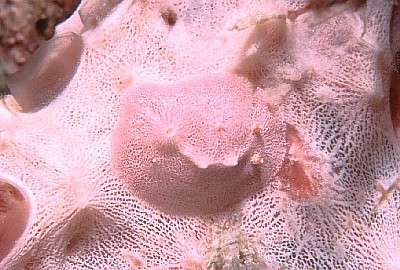
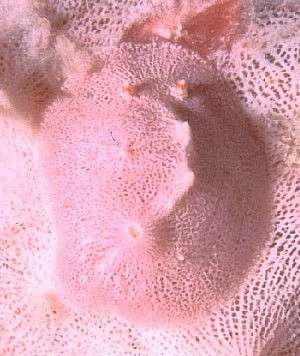
Doris? sp. 7.
Order: NUDIBRANCHIA
Suborder: DORIDINA
PHOTO
on Dysidea arenaria? in quiet lagoon areas in the Marshall Islands. approx 25mm long. PHOTO: Scott Johnston.
See message from Scott Johnston below.
Related messages
Another record of Doris sp 7
August 7, 2007
From: Mark Atwell
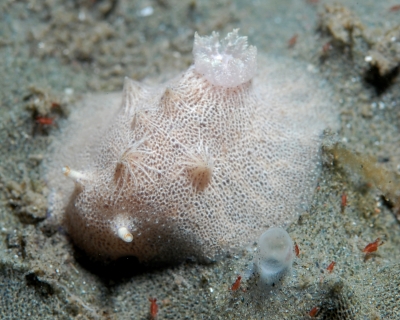
I have never seen a nudibranch quite like this. It has a visual texture like wool or a sponge's skeleton. It also seems to share some details - like camouflage - with the type of rock/coral it is on.
Locality: Bethlehem, near Minahasa Lagoon, Around 10 metres., Sulawesi, Indonesia, Celebes Sea, 01 May 2007, Ultra-fine muddy bottom . Length: About 3 cm.. Photographer: Mark Atwell.
Any ideas?
Mark Atwell
mark.atwell@gmail.com
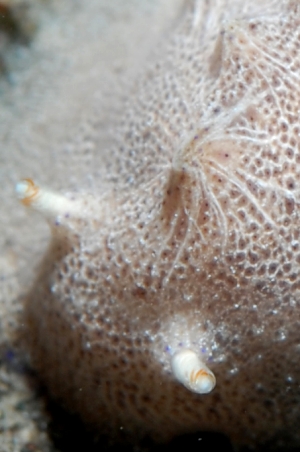
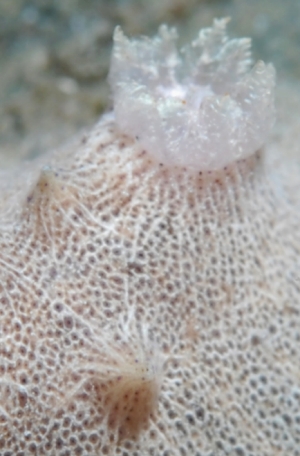
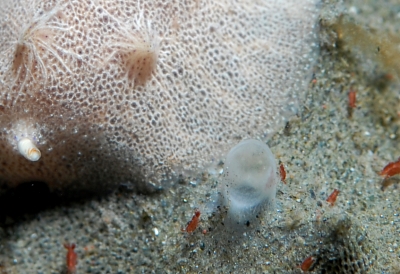
Dear Mark,
This is an interesting find. We have one earlier record of this species which I have called Doris? sp. 7 but I am sure it is not a species of Doris. From the shape of the small upright gill circlet, perhaps it is a species of Hallaxa.
You are also right to liken the mantle texture to that of a sponge and to liken it to the 'rock/coral it is on'. Everything in your photo is a trick. The rock/coral it is on is in fact a very cryptic sponge colony - Dysidea arenaria which incorporates sponge grains into its outer skin precisely to look like a sandy rock. And of course the nudibranch is doing its best to look like the sponge. Note that both have the same conical projections - which in the sponges disguise the exhalent water siphons when not in use. One that is in use is visible alongside the nudibranch in the close-up photo.
As Scott Johnson noted, this is a remarkable example of camouflage by both the sponge and the nudibranch.
Best wishes,
Bill Rudman
A classic case of camouflage
August 30, 1999
From: Scott Johnson

Hi Bill,
Here's a beast I've puzzled about for some time. It is always found well camouflaged on its prey pink sponge. I removed a specimen from the sponge to take two of the attached shots. The sponge was in the reference collection of the Mid-Pacific Research Lab as Dysidea arenaria, but I'm not sure where the id came from. The sponge, and therefore the nudibranch, are typically found in quiet lagoon areas in the Marshalls, sometimes even growing as an unattached clump out in the middle of a silty sandy bottom. The nudibranch ranges up to about 15mm and is soft in texture but more firm than a Chromodoris. Curiously, the radula and reproductive system are very chromodorid-like.
Scott
johnson@kmr.ll.mit.edu
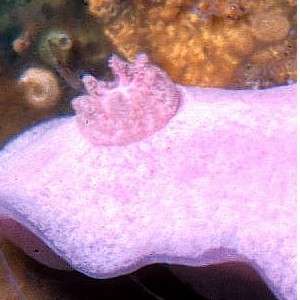

Dear Scott,
I know I shouldn't be surprised, but every time I see another masterly display of camouflage I am impressed. I know chromodorids aren't supposed to have a skin texture like a sponge but have a look at Verconia verconis, a cryptic chromodorid, endemic to southern Australia. Mind you the tight upraised gill circlet is also reminiscent of Actinocyclus and Hallaxa which have chromodorid-like radular teeth. Dorids feeding on sponges without spicules often have more elaborate denticulate teeth than those that feed on the tougher spiculate sponges.
Bill Rudman.
